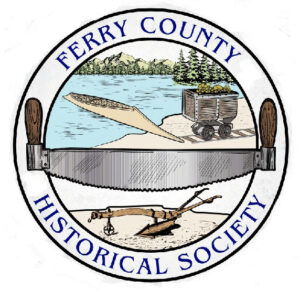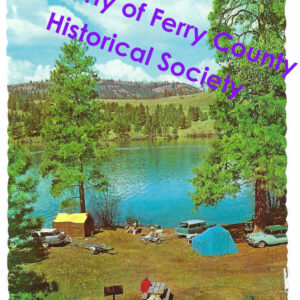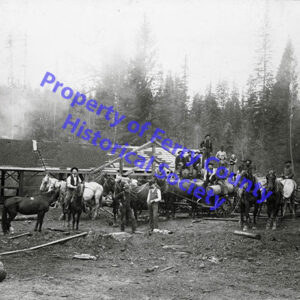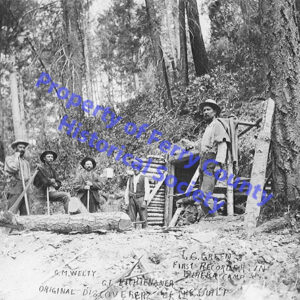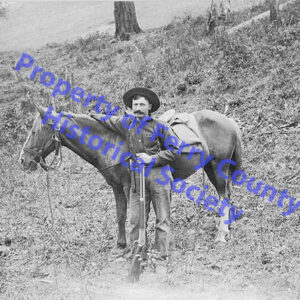New Logo
To your left you will see the FCHS’s new logo. Its history is described in a slightly abridged letter to the editor of the Ferry County View on August 2nd.The Ferry County Historical Society has a new logo. The design presents, in chronological orderfrom left to right, the early inhabitants of Ferry County. The sturgeon-nosed canoe represents the first peoples in the county with the ore car, crosscut saw and plow representing the next groups of settlers. The Colville Confederated Tribes helped develop and finalize the design.
“The sturgeon-nosed canoe is bark stretched over a frame,” said Council Chairman Jarred-Michael Erickson. “Named for the downward-pointing ends of both the bow and the stern, it was well-adapted to the varied water conditions of the river valleys of central British Columbia, home of the Sinixt. Its light weight and utility were admired by early European explorers, as was its ability to be quickly repaired when the bow hit a rock. The First Nations people sometimes stored their canoes for a season or longer by submerging them in the cold shoreline water, held fast by a few weighted stones.The design of the canoe is unique to this region of North America. Given the geography of the Sinixt Traditional Territory, the sturgeon-nosed canoe wasnever replaced by the horse as the most common mode of travel.”
The historical society’s board of trustees would like to thank those folks with the Tribes who helped us on this project for their valuable assistance and would also like to express our appreciation. A new sign will be installed in the Whitaker/Fletcher yard to identify and advertise our museum. There will be a slight difference in this sign as it will include the word “Museum” across the saw blade.
Rishiri student visits resume
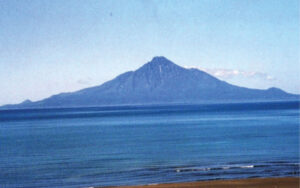
Rishiri Island in Japan’s far north, where Ranald MacDonald first made contact with Japanese people.
The pandemic interrupted the tours but they will begin again in October when we will welcome teacher Mr. Nobuyuki Okamoto, senior Kanata Shima and junior Youta Yamamoto. Mas Yatabe, Chairman of the Friends of MacDonald, will drive the students and their teacher to Astoria, where MacDonald was born, Jim Mockford, Friends of MacDonald member will drive them to Republic. They will arrive in Republic October 12th and the group will visit the gravesite the next day. The boys will give a brief presentation on Rishiri Island before dinner at 18 North Kitchen and Bar in Republic, time yet to be determined. Anyone interested in this continuation of Ranald MacDonald’s trans-Pacific contact is welcome to attend but seating is limited.
Mystery materials identified
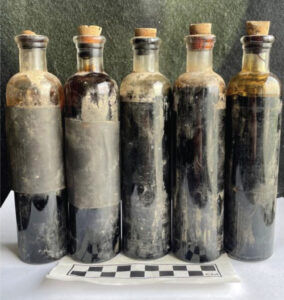
The five little bottles of toxic creosote found in the Whittaker/Fletcher attic.
Thanks to Dr. Ray von Wandruszka, Chair of the University of Idaho’s Chemistry Department, we now know what the mystery materials from the Republic Drugstore’s basement and Historical Society attic are.
The red/orange powder shown in the Spring Nugget tested as a lead glaze formerly used to finish ceramics. Its high lead content probably qualifies it as too hazardous to health for us to retain. The same is true of the contents of the five identical little bottles found in the attic of the Whittaker/
Fletcher House. These contain creosote, a toxic distillate of wood or coal tar used as a wood preservative. The third sample, a yellow powder, was identified as yellow ochre, a mineral pigment used in paint. This is a simplification of a very thorough chemical analysis. The complete reports are available on request from the Nugget editor. Dr. Wandruszka and his graduate students analyze unknown materials from archaeological sites and similar venues without charge.
Shutting down for the season
The Whittaker/Fletcher House Museum will be open to the public for the last time this year on Monday, September 4th. Hours for this last opportunity to explore our history are Friday through Monday, 10 a.m. to 2 p.m. Monday is the last day. The FCHS plans to open the museum again Memorial Day week-end, 2024. See you in May.
Yard sale planned
The FCHS Board has tentatively scheduled a fundraising yard sale for the Saturday of Memorial Day week-end. Any members and others who have saleable items to spare are encouraged to call Ray Bilderback at 509-775-2605. No junk, please.
Thanks!
A big thank-you and a tip of the hat to FCHS member Roland Thiele who has replaced a warped 2 x 4 in the railing at the railing on the Whittaker/Fletcher house museum and painted the railing, using much of his own equipment and FCHS paint. Thanks, Roland! It looks a lot better!
L. H. Mason Building (Hanks Second Hand, Anderson’s Feed)
Since the FCHS cannot afford to renovate and repurpose the L. H. Mason Building, the FCHS Board is exploring possibilities for the building and will update when we know more.
Fair booth
The Theme of this year’s FCHS booth at the Ferry County Fair is “Discovering Our Golden Past”, in keeping with the fair’s them “ Discovering Gold at the Ferry County Fair”. Maps and pamphlets will be available at the booth. Stop by and see us at Booth 2 on the south wall of the Exhibit Hall September 1-3.

